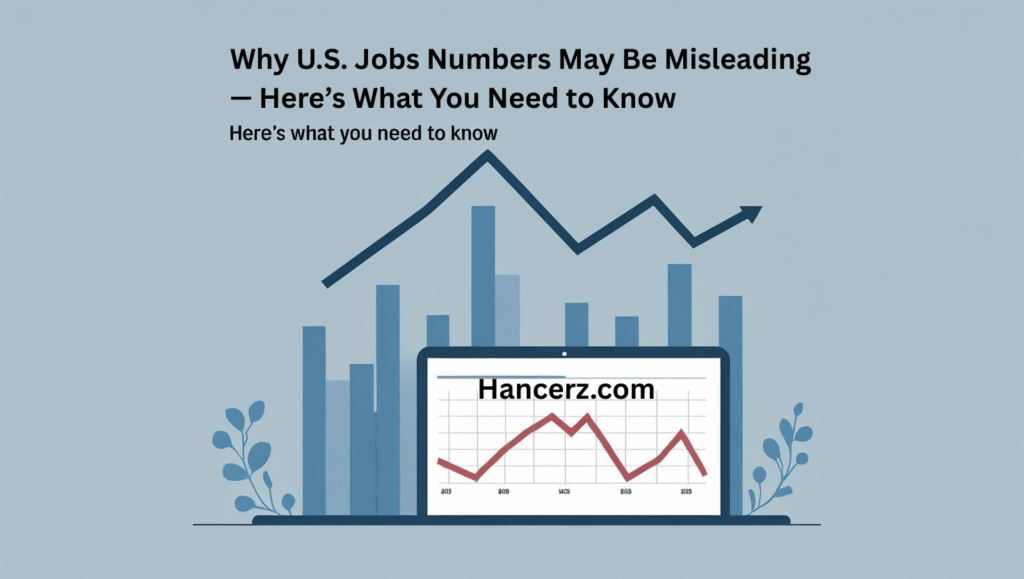Why America’s Jobs Data May Be Getting It Wrong
Quick Summary
The latest U.S. jobs figures look strong on the surface: low unemployment, steady hiring, and economic resilience. But a growing chorus of economists warns that these numbers might mask weakness. Key issues include flawed survey methods, understating labor force withdrawal, misclassifying gig and part-time work, and missing pockets of underemployment. In short, official data may be painting too rosy a picture of job-market health. Scroll down for a deep look at what’s going on—and how it matters to your wallet and career.
Breaking Down the Jobs Numbers
How official job data is collected
Every month, two primary reports are issued:
- The Establishment Survey (Payroll Report): Counts job creation from businesses—based on payroll submissions, not necessarily individual workers.
- The Household Survey: Reports employment status based on people’s responses—used to calculate the unemployment rate.
These reports can diverge. For example, businesses may report job additions, but worker-side interviews may show people exiting the labor force. That divergence is generating current concern. Nonfarm Payrolls.
Why the Data Might Be Off Track
A) Labor force dropouts
Many workers are simply not counted if they’ve stopped job searching. That removes them from the unemployment rate—even if they’d take a job under different conditions.
In regions hit by industrial decline or disrupted job expectations, discouraged workers may mask underlying weakness by exiting the data pool entirely.
B) Misclassification and gig roles
“Gig work,” side hustles, and part-time roles may get miscategorized. Someone working food delivery with minimal hours may not be labeled “employed” in a meaningful financial sense—even though they’re “working.”
That can skew perceptions of workforce health and wage growth.
C) Seasonal and statistical distortions
Certain months bring hiring boosts—think summer camps or retail ramps—then declines. Seasonal adjustment techniques try to smooth that, but aggressive corrections can hide real volatility.
D) Wage stagnation with job growth
Jobs may be increasing—but at low pay, limited hours, or in sectors with slim margins. That growth doesn’t always translate into household financial stability.
E) Survey reversal anomalies
There are times when the payroll report shows job gains, yet the household report signals unemployment rising. That discordance suggests the two mechanisms don’t always align—and policymakers may be confused.
Real-world Effects: What This Means for You
For policymakers:
Decisions on interest rates, benefits, and training programs may be based on overly optimistic data — potentially oversteering fiscal and monetary policy.
For workers:
If data masks job scarcity or underemployment, bailouts, wage support, or retraining programs may be inadequate.
For businesses:
Talent shortages may feel real even when numbers say hiring is easy; understanding local labor realities can drive better staffing strategies.
Facts & Figures Table
| Metric | Description |
|---|---|
| Unemployment Rate | Percentage of the labor force actively looking for work but not employed. |
| Labor Force Participation | Portion of the working-age population that is employed or actively seeking employment. |
| Payroll Job Gains | Net jobs added according to business payroll data. |
| Discouraged Workers | Those not looking for work due to belief no jobs are available. |
| Underemployment | Includes part-time workers wanting full-time, or those not measured by official categories. |
Voices of Concern
Economists from respected institutions have noted this trend: the unemployment rate falls not from hiring strength but from labor force exits. Meanwhile, small-business owners report shortages and wage pressures even when data claims balance. Policymakers now face the challenge of calibrating stimulus or caution amid ambiguous signals.
FAQs — Quick Clarity on Jobs Data Issues
Q: Why does unemployment fall even if jobless people are growing?
If many people give up looking for work, they’re no longer classified as unemployed—even if they still want a job.
Q: Can we trust payroll job growth figures?
Payroll data reflects hours paid, not necessarily the quality or sustainability of work. It also misses informal or gig work.
Q: How do seasonal adjustments skew outlooks?
Adjustments estimate what “typical” hiring should be—big deviations (like mass AI layoffs or retail holiday spikes) can derail those models.
Q: Is underemployment part of the official job figures?
Not well. Part-timers who want more hours or those in precarious gig roles are often undercounted or misclassified.
What Comes Next — A Realistic Path Forward
- Use multiple labor metrics, not just unemployment. Pay attention to participation, hours worked, regional trends.
- Encourage granular analysis—state, city-level data may reveal gaps that national figures obscure.
- Combine official data with real-time analytics, like job postings, payroll processing, and app-based gig indicators.
- Invest in worker surveys and partnerships with universities or labor groups to fill data gaps.
Final Reflection
America’s headline job numbers may look strong—but peeling back the layers reveals cracks: missing workers, headline-job illusions, and wage stagnation. If we’re going to build resilient policy, informed businesses, and secure retirement pathways, we need to look beyond the surface—and rewrite how we interpret the “health” of work.
Want more labor market insights and breakdowns?
Subscribe to Hancerz Insights—where complex data turns into clear understanding for your career, wallet, and world.




